Abstract
We sought to characterize the inorganic carbon pool (CO2 plus HCO3−) formed in the leaves of C4 plants when C4 acids derived from CO2 assimilation in mesophyll cells are decarboxylated in bundle sheath cells. The size and kinetics of labeling of this pool was determined in six species representative of the three metabolic subgroups of C4 plants. The kinetics of labeling of the inorganic carbon pool of leaves photosynthesizing under steady state conditions in 14CO2 closely paralleled those for the C-4 carboxyl of C4 acids for all species tested. The inorganic carbon pool size, determined from its 14C content at radioactivity saturation, ranged between 15 and 97 nanomoles per milligram of leaf chlorophyll, giving estimated concentrations in bundle sheath cells of between 160 and 990 micromolar. The size of the pool decreased, together with photosynthesis, as light was reduced from 900 to 95 microeinsteins per square meter per second or as external CO2 was reduced from 400 to 98 microliters per liter. A model is developed which suggests that the inorganic carbon pool existing in the bundle sheath cells of C4 plants during steady state photosynthesis will comprise largely of CO2; that is, CO2 will only partially equlibrate with bicarbonate. This predominance of CO2 is believed to be vital for the proper functioning of the C4 pathway.
Full text
PDF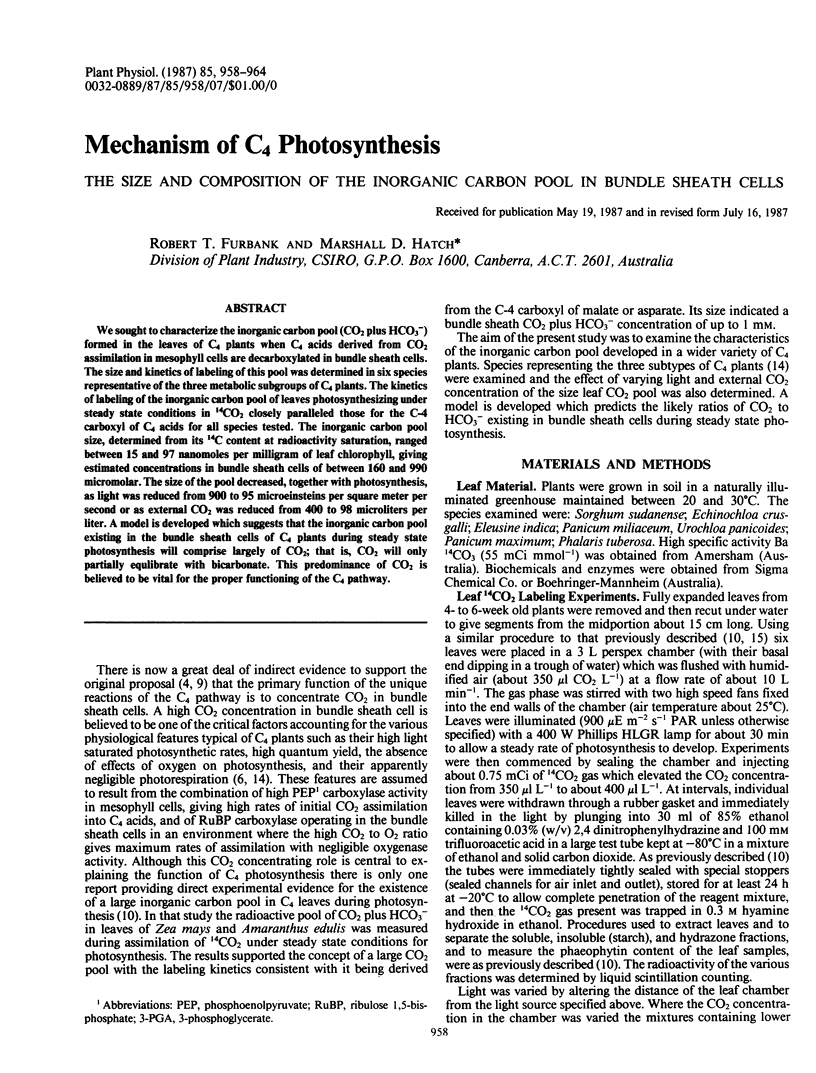
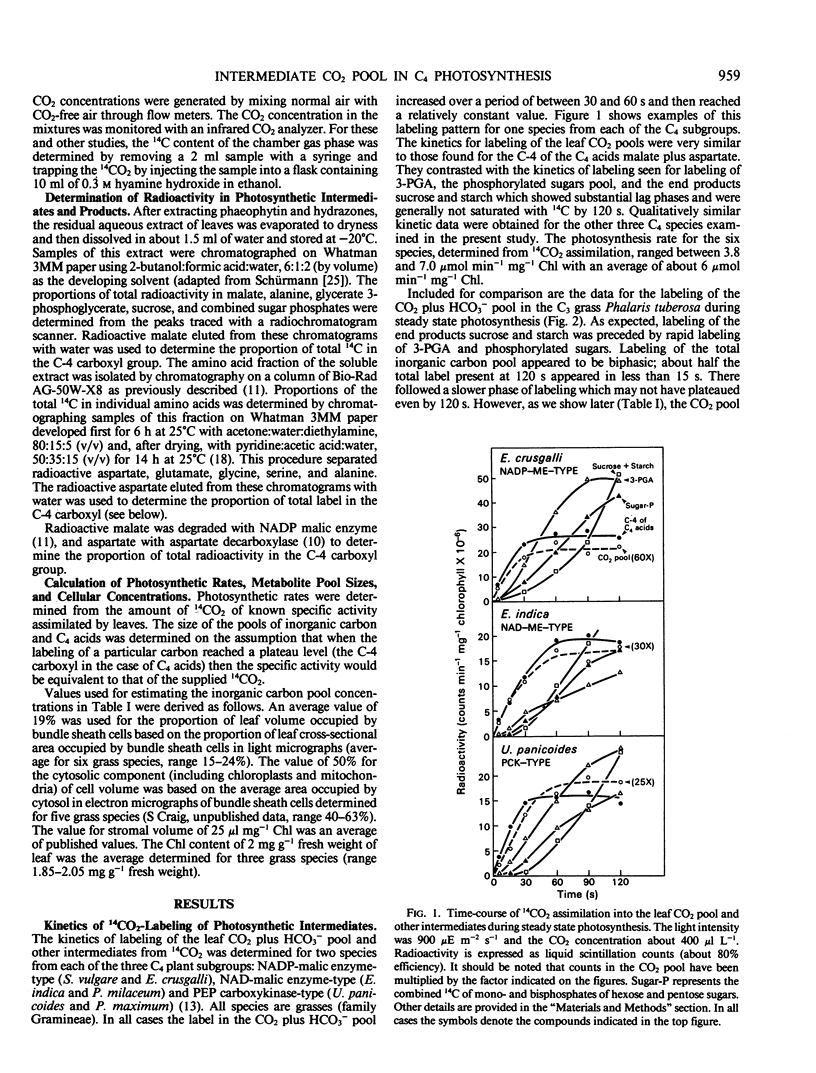
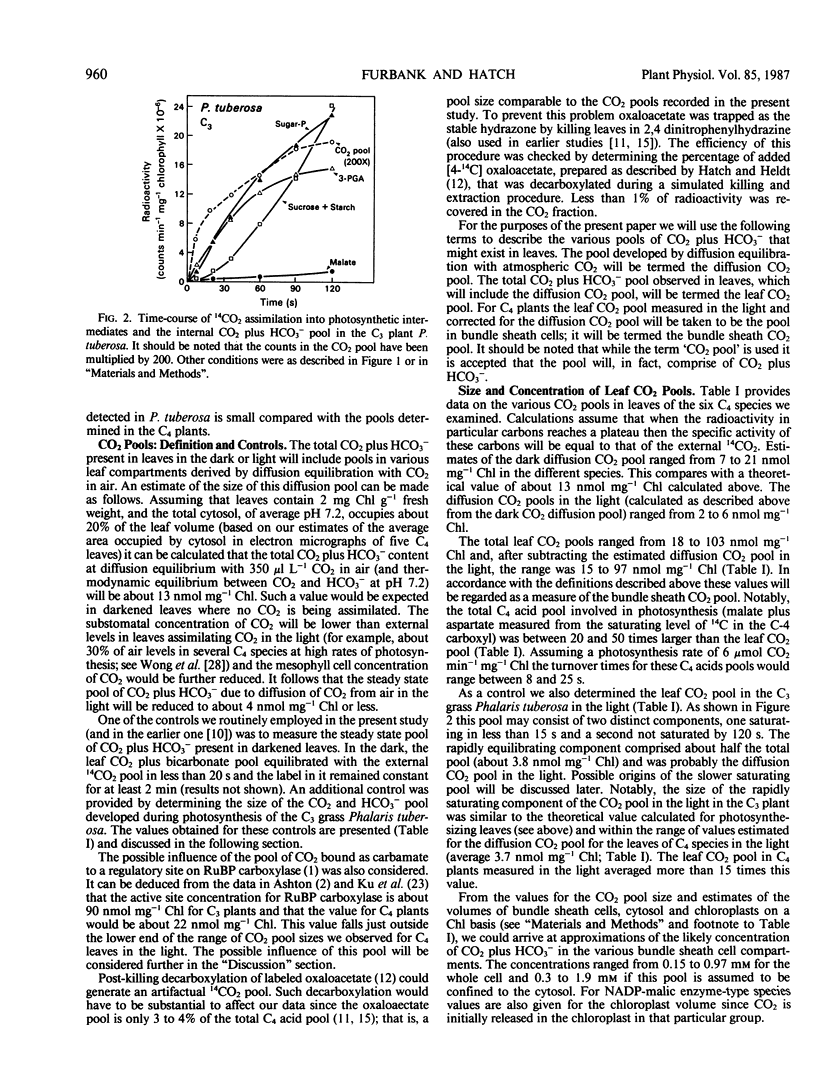
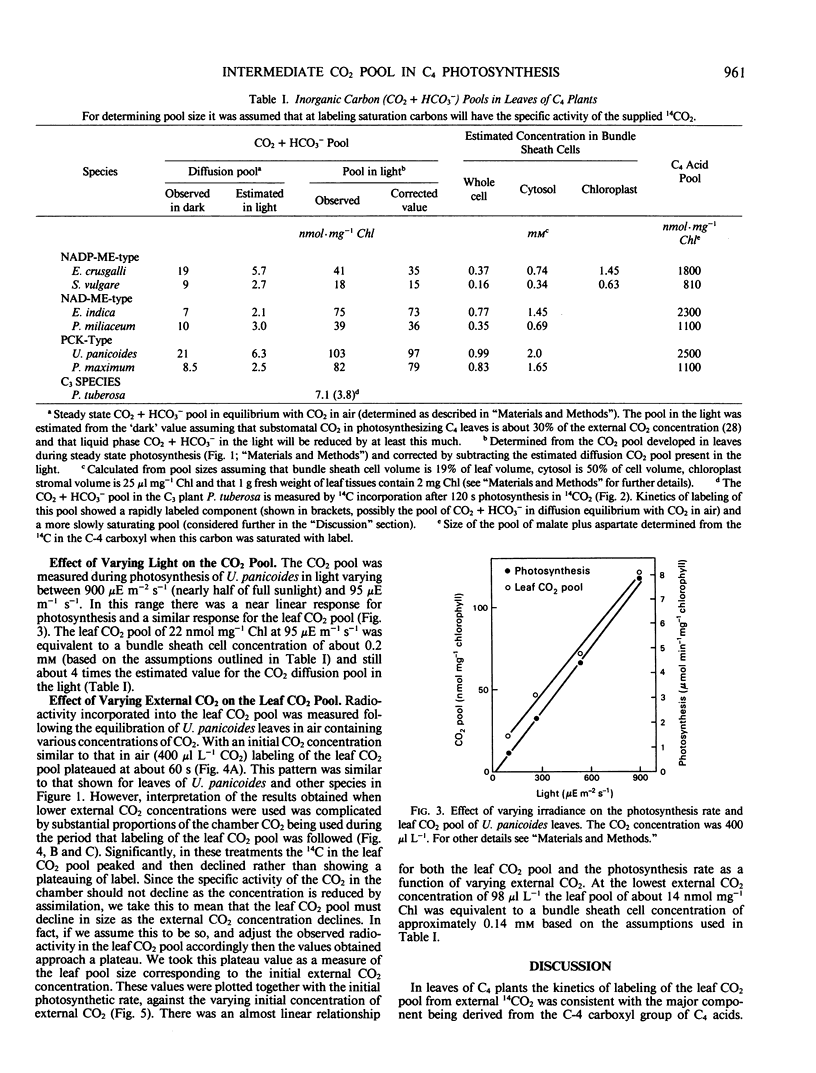

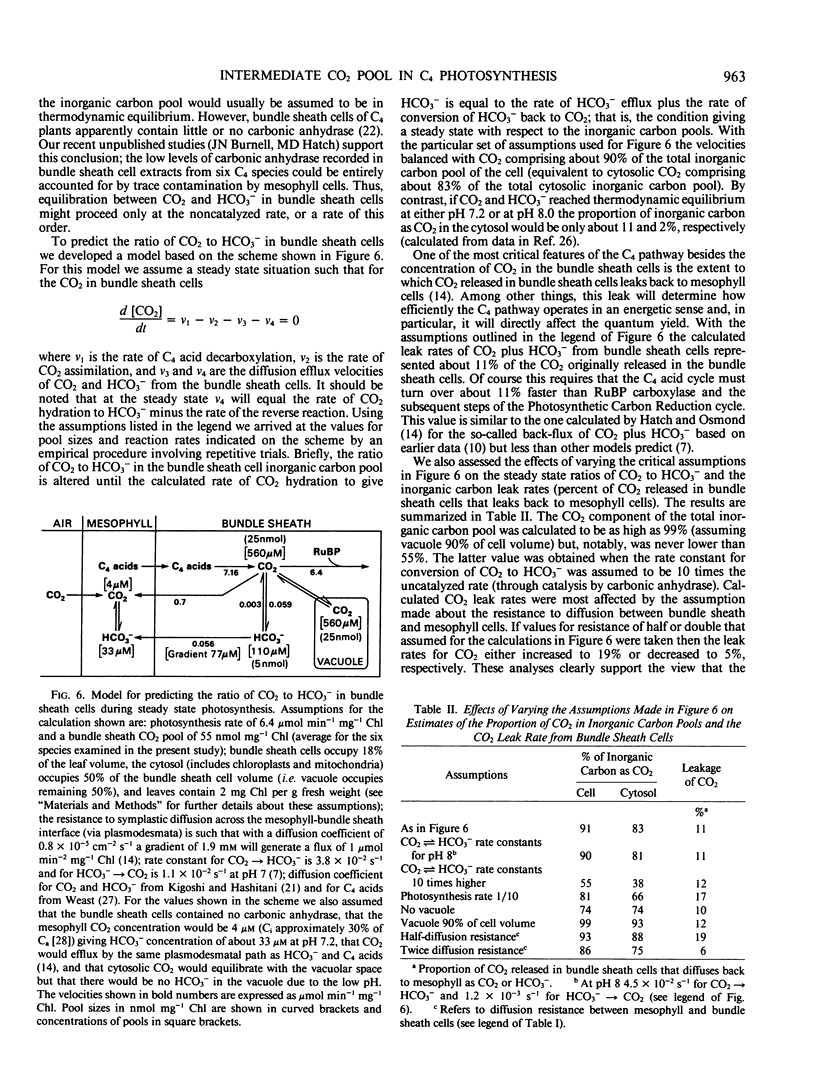
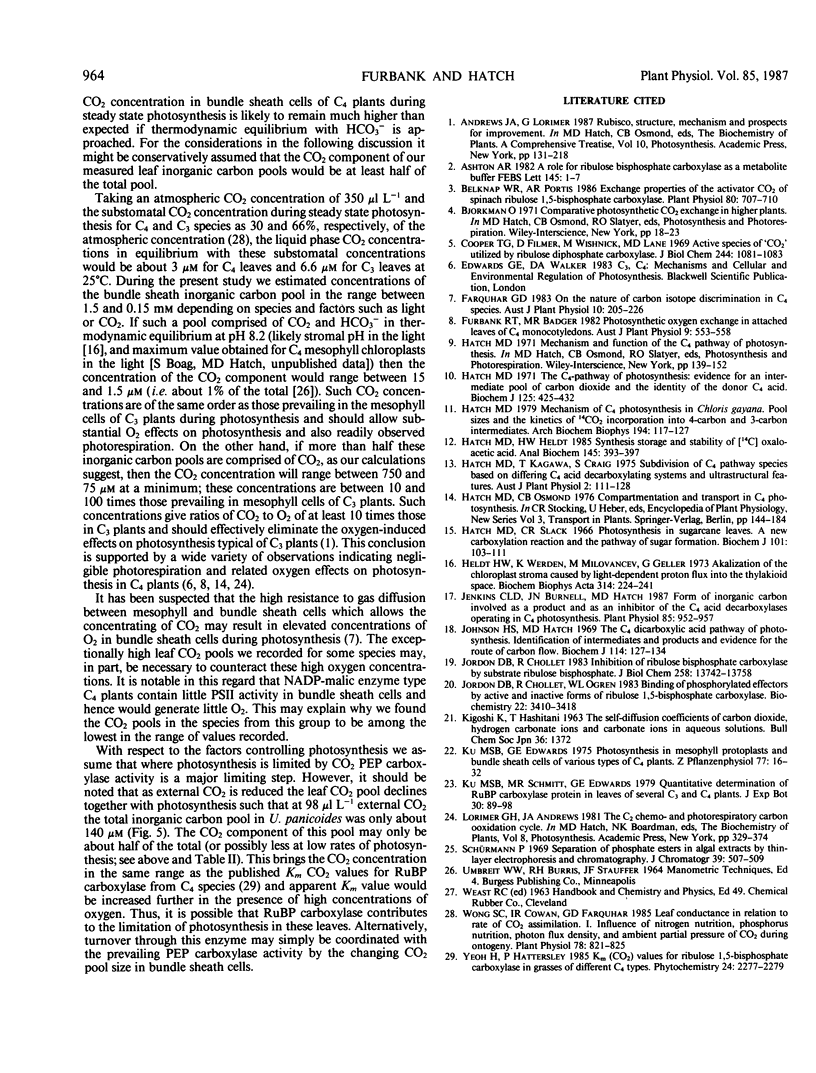
Selected References
These references are in PubMed. This may not be the complete list of references from this article.
- Belknap W. R., Portis A. R. Exchange Properties of the Activator CO(2) of Spinach Ribulose-1,5-Bisphosphate Carboxylase/Oxygenase. Plant Physiol. 1986 Mar;80(3):707–710. doi: 10.1104/pp.80.3.707. [DOI] [PMC free article] [PubMed] [Google Scholar]
- Cooper T. G., Filmer D. The active species of "CO2" utilized by ribulose diphosphate carboxylase. J Biol Chem. 1969 Feb 10;244(3):1081–1083. [PubMed] [Google Scholar]
- Hatch M. D., Heldt H. W. Synthesis, storage, and stability of [4-14C]oxaloacetic acid. Anal Biochem. 1985 Mar;145(2):393–397. doi: 10.1016/0003-2697(85)90379-3. [DOI] [PubMed] [Google Scholar]
- Hatch M. D. Mechanism of C4 photosynthesis in Chloris gayana: pool sizes and kinetics of 14CO2 incorporation into 4-carbon and 3-carbon intermediates. Arch Biochem Biophys. 1979 Apr 15;194(1):117–127. doi: 10.1016/0003-9861(79)90601-5. [DOI] [PubMed] [Google Scholar]
- Hatch M. D., Slack C. R. Photosynthesis by sugar-cane leaves. A new carboxylation reaction and the pathway of sugar formation. Biochem J. 1966 Oct;101(1):103–111. doi: 10.1042/bj1010103. [DOI] [PMC free article] [PubMed] [Google Scholar]
- Hatch M. D. The C 4 -pathway of photosynthesis. Evidence for an intermediate pool of carbon dioxide and the identity of the donor C 4 -dicarboxylic acid. Biochem J. 1971 Nov;125(2):425–432. doi: 10.1042/bj1250425. [DOI] [PMC free article] [PubMed] [Google Scholar]
- Heldt W. H., Werdan K., Milovancev M., Geller G. Alkalization of the chloroplast stroma caused by light-dependent proton flux into the thylakoid space. Biochim Biophys Acta. 1973 Aug 31;314(2):224–241. doi: 10.1016/0005-2728(73)90137-0. [DOI] [PubMed] [Google Scholar]
- Jenkins C. L., Burnell J. N., Hatch M. D. Form of inorganic carbon involved as a product and as an inhibitor of c(4) Acid decarboxylases operating in c(4) photosynthesis. Plant Physiol. 1987 Dec;85(4):952–957. doi: 10.1104/pp.85.4.952. [DOI] [PMC free article] [PubMed] [Google Scholar]
- Johnson H. S., Hatch M. D. The C4-dicarboxylic acid pathway of photosynthesis. Identification of intermediates and products and quantitative evidence for the route of carbon flow. Biochem J. 1969 Aug;114(1):127–134. doi: 10.1042/bj1140127. [DOI] [PMC free article] [PubMed] [Google Scholar]
- Jordan D. B., Chollet R. Inhibition of ribulose bisphosphate carboxylase by substrate ribulose 1,5-bisphosphate. J Biol Chem. 1983 Nov 25;258(22):13752–13758. [PubMed] [Google Scholar]
- Schürmann P. Separation of phosphate esters and algal extracts by thin-layer electrophoresis and chromatography. J Chromatogr. 1969 Feb 25;39(4):507–509. [PubMed] [Google Scholar]
- Wong S. C., Cowan I. R., Farquhar G. D. Leaf Conductance in Relation to Rate of CO(2) Assimilation: I. Influence of Nitrogen Nutrition, Phosphorus Nutrition, Photon Flux Density, and Ambient Partial Pressure of CO(2) during Ontogeny. Plant Physiol. 1985 Aug;78(4):821–825. doi: 10.1104/pp.78.4.821. [DOI] [PMC free article] [PubMed] [Google Scholar]


